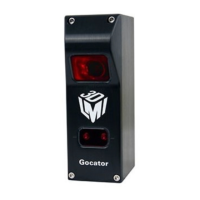Gocator Line Profile Sensors: User Manual
Protocols • 639
EtherNet/IP Protocol
EtherNet/IP is an industrial protocol that allows bidirectional data transfer with PLCs. It encapsulates the
object-oriented Common Industrial Protocol (CIP). EtherNet/IP communication enables the client to:
l Switch jobs.
l Align and run sensors.
l Receive sensor states, stamps, and measurement results.
l Set and retrieve runtime variables.
This section describes the EtherNet/IP messages and data formats.
Note that in firmware version 5.2, the identity information was updated as follows:
Attribute Before Firmware 5.2 Firmware 5.2 and later
Product Code Was 1000, 2000, or 3000
depending on the model.
Now 1.
Major Revision Matched firmware major
version.
Now 1.
Minor Revision Matched firmware minor
version.
Now 1.
This update may require a change on a device attempting to connect to a Gocator sensor via
EtherNet/IP. A compatible EDS file can be downloaded from the Gocator web interface. If the existing
EDS must be maintained, the device can be configured to disable electronic keying, ignoring the product
code and version numbers.
To use the EtherNet/IP protocol, it must be enabled and configured in the active job. For information on
configuring the protocol using the Web interface, see Ethernet Output on page 434.
The Gocator 4.x firmware uses mm, mm
2
, mm
3
, and degrees as standard units. In all protocols,
values are scaled by 1000, as values in the protocols are represented as integers. This results in
effective units of mm/1000, mm
2
/1000, mm
3
/1000, and deg/1000 in the protocols.
Gocator supports unconnected or connected explicit messaging (with TCP), as well as implicit (or I/O)
messaging. For information on explicit messaging assemblies and objects, see Explicit Messaging below.
For information on implicit messaging assemblies and objects, see Implicit Messaging on page 646.
Explicit Messaging
To EtherNet/IP-enabled devices on the network, the sensor information is seen as a collection of objects,
which have attributes that can be queried.
Gocator supports all required objects for explicit messaging, such as the Identity object, TCP/IP object,
and Ethernet Link object. In addition, an Assembly object is used for sending sensor and sample data
and receiving commands. The Assembly object contains four assemblies: the command assembly (32
bytes), the runtime variable configuration assembly (64 bytes), the sensor state assembly (100 bytes),
